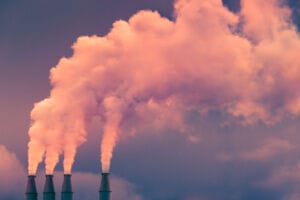Salt River Project this week will begin a three-week test burn of more than 3,900 tons – or about 300 acres – of forest debris biomass at its Coronado Generating Station (CGS). The test is planned as part of the continued stewardship of Arizona’s water and power resources by evaluating the viability of reducing fire risk to Arizona’s fire-prone watersheds while creating renewable power from forest byproducts.
The first scheduled test at CGS Unit 1 in St. Johns will be a one-day, two-load burn on Wednesday to evaluate the power plant’s coal-handling system’s ability to integrate the biomass. If the one-day test burn is successful, a full system test will commence with a 2 percent mixture of biomass on Nov. 3 and will last10 days, followed by a 5 percent mixture of biomass starting Nov. 17 and lasting 10 days.
The test burn will be the first of its kind in Arizona in which forest debris will be co-burned with coal. Information gained from the test will help SRP understand the feasibility of integrating the biomass fuel into a plant designed to burn coal.
The biomass to be used in the test burn is a byproduct of forest-restoration activities taking place on state lands in northern Arizona. The restoration activities are part of a statewide effort to reduce the growing risk that catastrophic wildfires pose on communities, water supplies and Arizona’s natural resources. A market-based use for the biomass resulting from restoration activities is necessary to help pay for the millions of acres of Arizona forests that are at risk to catastrophic wildfire and in need of restoration.
SRP will use the 20-day study period to evaluate the feasibility of using forest debris on a very limited scale as a supplemental fuel at CGS to improve the health of Arizona’s forests and watersheds and to help with the challenges associated with forest-thinning biomass. The test, which will not require any permanent modifications to the power plant, will help identify cost-effective solutions and evaluate the potential impacts to the fuel-handling system, pulverizers, boiler and emission-control systems at CGS.
The Coronado facility in eastern Arizona was not designed to burn biomass, which is not a fuel of choice for utilities because it is less efficient in producing heat to generate electricity and is generally more expensive than traditional resources. In the forest-restoration process, trees are harvested to reduce the fire risk, leaving behind tons of low-value woody biomass that would otherwise be placed in large piles and burned – and often creating emissions and smoke for local residents.
If successful, the test burn will help SRP understand whether some of the technical challenges of burning Ponderosa pine tree and branch clippings at a sophisticated coal-fired facility can be adequately addressed and if it will have a potential positive impact on Arizona’s forests. Reducing the risk of wildfires in northern Arizona will reduce erosion, sedimentation and ash in the Salt and Verde river watersheds, protecting vital water supplies for residents, businesses and agriculture in the greater Phoenix metropolitan area as well as the state’s rural communities.
SRP worked with multiple agency partners to plan and fund the test burn. Agency partners include the Arizona State Land Department, the Arizona State Forestry Department, the Arizona Department of Administration as well as the Governor’s Office, which secured a grant through the U.S. Department of Energy as partial funding of the project. SRP selected Campbell Global, Perkins Timber Harvesting and Landstar Trucking to contract for the procurement and delivery of the woody biomass materials.
Coronado, owned and operated by SRP, was completed in 1980 and uses coal as a fuel to generate electricity from two 400-megawatt units for SRP customers in the Valley. SRP recently completed a $470-million project at the plant to install new emission-control technology that further reduces sulfur dioxide, nitrogen oxide and mercury emissions.
SRP is a community-based, not-for-profit public power utility and the largest provider of electricity in the greater Phoenix metropolitan area, serving more than 1 million customers. SRP also is the metropolitan area’s largest supplier of water, delivering about 800,000 acre-feet annually to municipal, urban and agricultural water users.




